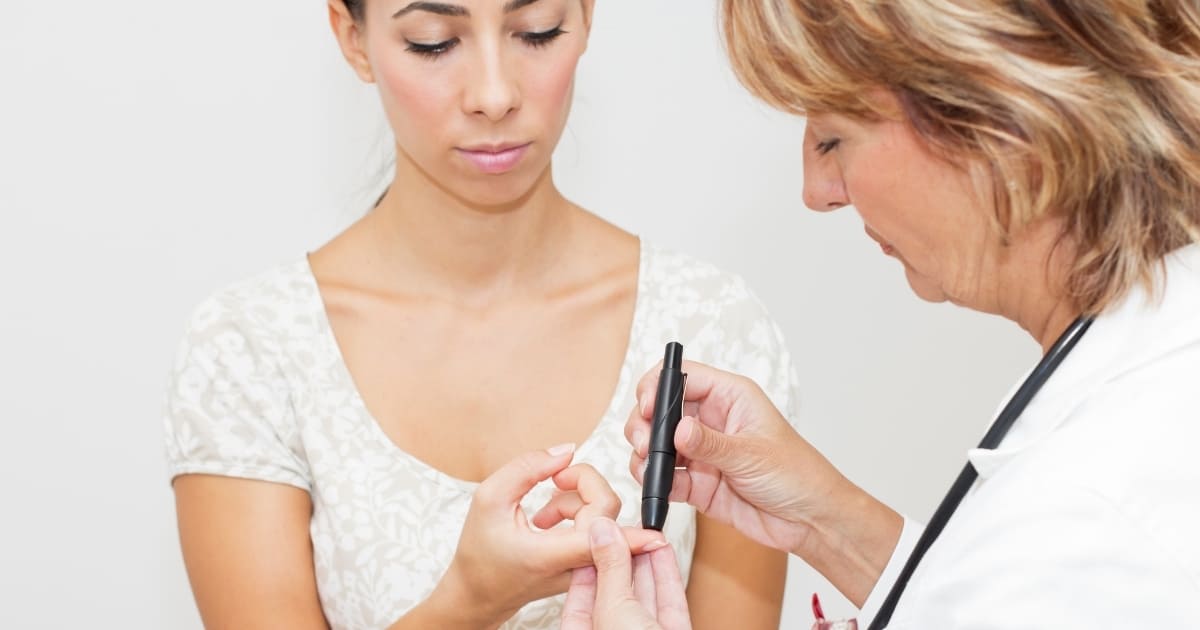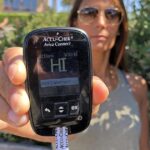This post may contain affiliate links. Please read the disclosure.
Diabetes can develop dangerously fast and can be extremely dangerous to your health and life.
If you are experiencing symptoms of diabetes, such as extreme hunger, thirst, weight loss, frequent urination, blurred vision, and fruity scented breath, you should test your diabetes as soon as possible.
Getting a diabetes test is the only way to ensure you know if you have a condition.
Who should get tested for diabetes?
If you are thinking about getting a test for diabetes, you should probably do so as there is little risk of taking the test.
There are very few false “positives” and are cheap, easy and can provide a sense of security.
Here are some reasons why you’re being tested for diabetes:
- You have a family history of illness (type 1 or type 2)
- There are several risk factors for disease: living a sedentary lifestyle, overweight or obese, over 45 years of age, or living with hypertension or heart disease
- You are experiencing symptoms of diabetes. These include rapid weight loss, extreme thirst, frequent need to urinate, blurred vision, extreme fatigue, and breath of fruity scent.
- I currently have prediabetics
- You are pregnant and have a family (or personal) history of gestational diabetes
It is possible to suffer from type 2 diabetes or type 2 diabetes with few or no symptoms, so if you are in a high-risk group, it is recommended that you do a blood test at your annual doctor’s visit or test your blood glucose level annually at a home test.
How difficult is it to get tested for diabetes?
Getting a diabetes test is very easy and can be done with a blood test at home or at the clinic.
There are two different types of blood tests that can be used to detect diabetes.
Finger Stick Test
Fingerstick tests are performed on a glucometer that can be purchased at the counter at a local pharmacy and performed at home or at the doctor’s office.
This test will measure what your blood sugar level is now. Blood sugar levels in people who do not suffer from diabetes are as follows:
- Fasting blood sugar (morning, before eating): <100 mg/dl
- 1-2 hours after meals: less than 140 mg/dl
- 2-3 hours after meal: less than 100 mg/dl
If your glucose level exceeds 100 mg/dl more than 2 hours after meals, you probably have diabetes or prediabetes.
However, certain diabetes diagnosis can only be made after a more accurate lab test, so if your blood sugar levels are high, you should always consult your doctor immediately.
you can Buy 100 fingers sexually transmitted glucometers on Amazon For $25, test your blood sugar level on a regular basis yourself.
HBA1C Test
The HBA1C test is the main blood test used to diagnose diabetes. Measures the average blood glucose level over the past three months.
You can test in your doctor’s office or use a test kit to measure your A1C at home.
The American Diabetes Association has established the following A1C guidelines for using tests as part of a diabetes diagnosis:
you can Buy A1C Test Kit on Amazon $65.
As demonstrated in this short video, the home test kit is extremely easy to use.
If your A1C test indicates that you have diabetes or prediabetics, see your doctor immediately, do more tests and start a treatment program.
Gestational diabetes test
There is a daily oral glucose tolerance test given to all pregnant women in a pregnancy of about 28 weeks, where you drink a sweet glucose solution (usually containing about 50 grams of sugar!), your doctor will measure it a few hours later (with a finger stick test) to see how your body (and pancries) reacts a few hours later.
Gestational diabetes rarely occurs before 26-28 weeks of pregnancy, but if you are worried about insulin resistance and the onset of diabetes earlier, the test can be ordered early.
If you are pregnant and have been tested for gestational diabetes via an oral glucose tolerance test, blood glucose levels below 140 mg/dL are normal after 2 hours of drinking the liquid, and blood glucose levels between 140 and 199 mg/dL indicate prediabetes.
Doctors usually do these tests twice if they feel that there is a mistake or if they want to confirm the diagnosis.
Is the test accurate?
It’s possible to suffer from diabetes, but these blood tests may be negative (this may mean you’re currently experiencing hypoglycemia!), or you don’t have diabetes, but your blood glucose levels are being tested higher than normal (probably forgot to fast on the fasting blood glucose test).
There are always outliers. Therefore, doctors may prefer to repeat the test before making a final diagnosis.
However, unless the glucometer is malfunctioning or there is misunderstanding in the lab, these tests are very reliable and can in most cases provide an accurate diabetes diagnosis.
Can you tell me what type of diabetes you have in these tests?
No, it’s just that you have diabetes. It is important to know the type you have, as treatment can depend on the type of diabetes you have.
Many doctors only look at the patient’s age, weight and family history to diagnose the type of diabetes.
This leads to many people over the age of 30 at the time of diagnosis, and is actually misdiagnosed as type 2 if they have type 1 diabetes or LADA (potential autoimmune diabetes in adults).
If you have been diagnosed with type 2 diabetes, we highly recommend that you also make an “autoantibody” test. Autoantibodies are proteins that are present when the immune system begins to attack itself, leading to autoimmune diseases.
If autoantibodies are present, you have type 1 diabetes or LADA, and require a different treatment regime than those with type 2 diabetes.
How expensive are these tests?
The good news is that getting a diabetes test is very simple and not too expensive. If you want to test it in the comfort of your own home, you can buy over-the-counter glucometers for $25-30 at the pharmacy or Amazon.
The A1C Home Test Kit with 4 Tests costs around $65 on Amazon.
You may also have a quick glucometer test at your primary care physician’s office, but you will have to pay your own self-pay to be seen. The cost depends on health insurance coverage.
While taking the HBA1C test in a doctor’s office is quite routine, the cost depends on the type of insurance you have. Lab services are typically run for a self-paying of between $5-50.
Without insurance, all this is more expensive, but if you have undiagnosed diabetes and feel you don’t have insurance, go to your local emergency department and immediately watch your doctor.
Should I test a child who is predisposed to diabetes?
yes! If you live in your own condition, you may be worried about your child or child developing diabetes.
This is reasonable. According to the American Diabetes Association, if you are a man who lives with type 1 diabetes, the chances of your child having type 1 diabetes are 1 in 17. If a woman suffers from type 1 diabetes and gives birth before the age of 25, the risk is 1/25.
If you give birth to a child after the age of 25, the risk of the child is one in 100, almost the same as the general population.
Fortunately, there are currently antibody tests available to determine risk for children. In particular, whether a family member with type 1 diabetes has siblings. These tests measure antibody responses to insulin, pancreatic islet cells, or enzymes called glutamate decarboxylase (GAD).
High levels of antibody responses indicate high in children Possibility It is the development of type 1 diabetes, but it does not guarantee that it will do so.
If you live with type 2 diabetes or have type 2 diabetes in your family, the chances of your child developing type 2 diabetes are also increased, but not guaranteed.
If you are interested in requesting antibody tests from your child, consult your doctor, especially if you or their siblings already live with diabetes.
FAQ
If you are experiencing symptoms of diabetes, such as extreme hunger, thirst, weight loss, frequent urination, blurred vision, and fruity scented breath, you should test your diabetes as soon as possible.
Yes, diabetes can be easily detected during routine blood tests.
Yes, you can test your home diabetes test with the HBA1C test, which you can buy online. However, if you test positive, you should always contact your healthcare team immediately so that additional tests can be performed to confirm your diagnosis and start a treatment program.
Yes, but they are not as accurate as blood tests and are not used for screening for diabetes
summary
With the rates of type 1, type 2, and gestational diabetes continuing to grow in the US, it is more important than ever to know how to test for diabetes if you think there are cases where your condition is not diagnosed.
The only definitive way to diagnose diabetes is by using a blood test, measuring the amount of glucose in the blood in milligrams (mg/dl) per decilitor, which can be done in the laboratory to measure hemoglobin A1c (HBA1C) or with a rapid finger tentacle test measured with a glucometer.
Pregnant people are routinely tested for gestational diabetes during pregnancy for 26-28 weeks with an oral glucose tolerance test.
Depending on your health insurance, getting a diabetes test is easy and relatively inexpensive.
However, if you have experienced symptoms of diabetes symptoms for several days, seek emergency medical attention immediately.
These are classic diabetic symptoms that medical professionals need to deal with immediately, especially if you have rapid weight loss, extreme thirst, fatigue, blurred vision, fruity scented breathing, and frequent urination.









